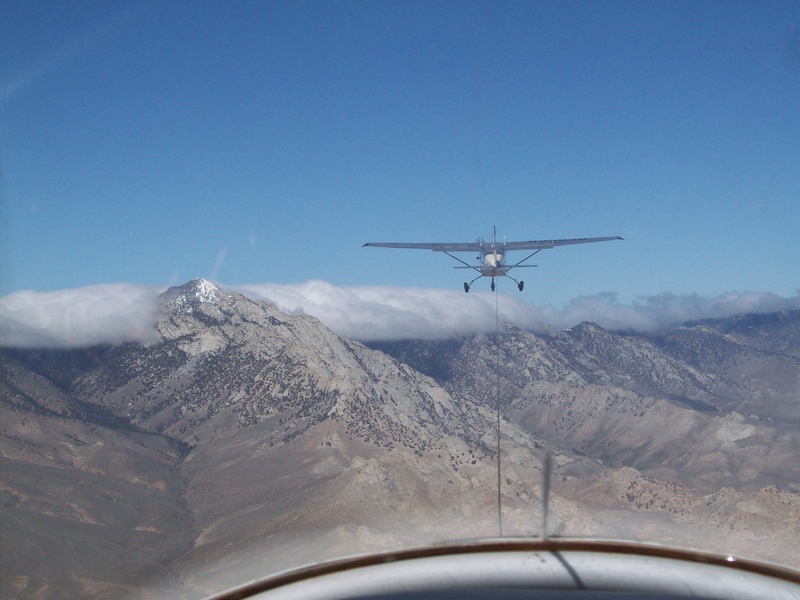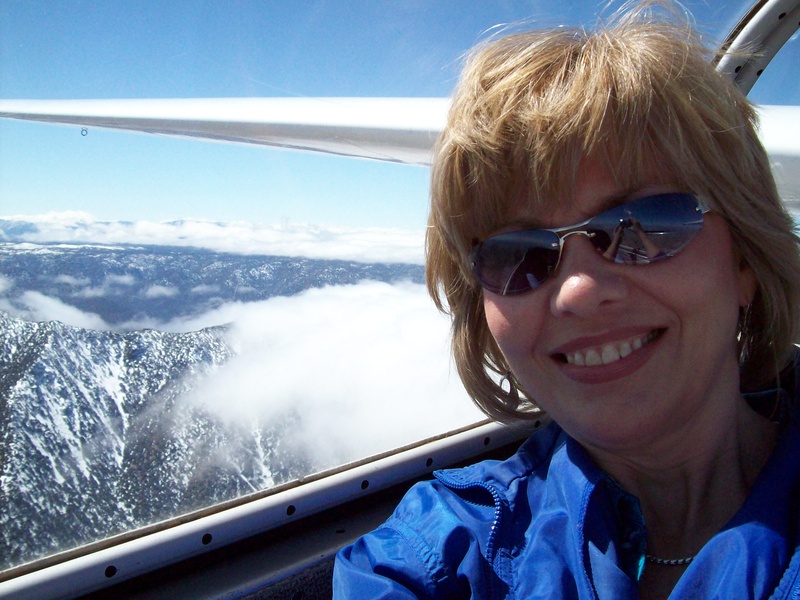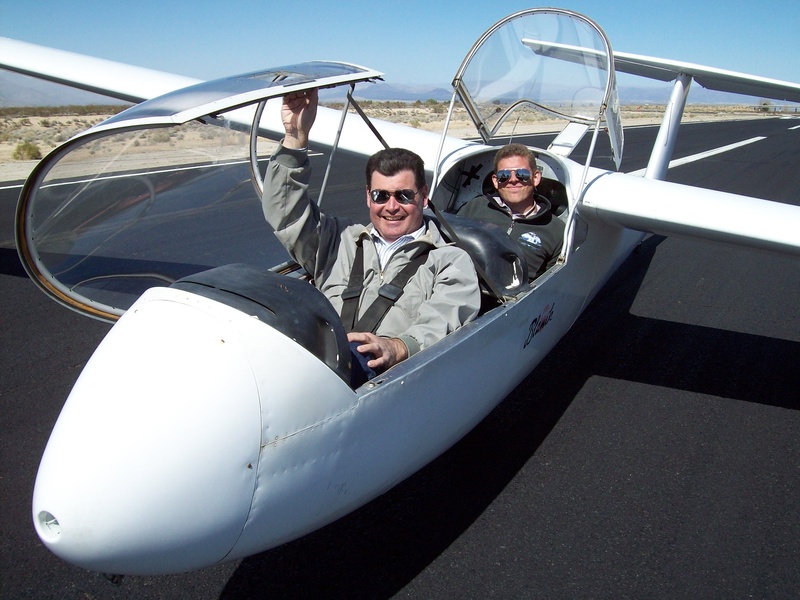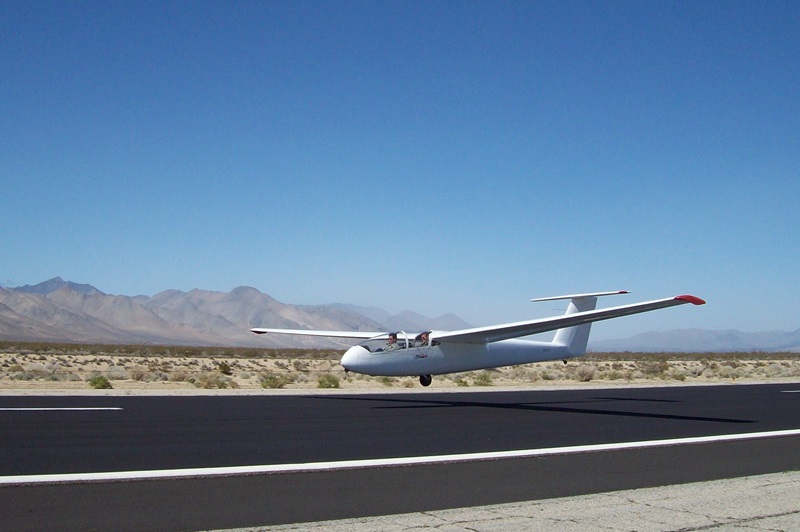Sierra Soaring Adventure
Written by David and Lisa Johnson
March 21, 2010
Lisa and David Johnson recently traveled to Ridgecrest California to visit our seven month old granddaughter Amelia, our son and daughter in law, Chris and Lucky; and our son Kevin. We had a wonderful visit. It was really great to see the kids and the Southern California weather felt so warm compared to the Southern Missouri winter we have been experiencing.
One of the things we wanted to do while on this visit was to go for a ride with Kevin in a glider, which we now know is called a sailplane. Kevin joined the Sierra Soaring Club in Inyokern shortly after moving to Ridgecrest about a year and a half ago, and he earned his private pilot license with a glider rating in October 2009. The Sierra Nevada Mountains to the west of Inyokern, and the prevailing winds over the mountains create a mountain wave and ridge lift. The desert floor around Inyokern heats up during the day creating thermals. These conditions create lift, upward moving air currents, that are great for soaring. Mountain wave is more prevalent during the winter months and thermals are more prevalent in the summer months. These conditions make Inyokern a very popular location for soaring.

We learned that there is a bit more preparation required for a sailplane flight than for a powered plane. One has to arrange for a tow pilot, ground crew, and the weather is very critical to a successful flight. Kevin did not consider it safe to fly with crosswinds greater than 25 Knots. We watched the weather forecast through the early part of the week and on Wednesday night decided that the conditions predicted for Saturday warranted contacting the tow pilot and making arrangements for our flights.
Saturday started out very windy and we feared we would have to scrub our flights, but we decided to go to the airport anyway (if you can’t fly, the next best thing is to be around planes). When we got to the airport the winds died down a little and we decided to at least get things out and prep the sailplane in case the wind settled some more. Sierra Soaring Club has 2 sailplanes, a Super Blanik L23 (two seat sailplane) and a Schweizer SGS 1-35 (single seat sailplane). At about 11AM the wind gusts were down to about 22 knots and declining while shifting down the runway, so we decided to give flying a go.
Our tow plane was a Cessna 182 piloted by Dan Kline. Dan was also Kevin’s glider flight instructor. The Cessna 182 is outfitted with an OWL STOL kit along with a tail hook for the special purpose of being a tow plane. The Super Blanik was pulled onto the runway. Lisa and Kevin strapped into the seats and the tow line was secured. Kevin signaled he was ready for take off, and in a matter of seconds they were airborne.
Dan towed Kevin and Lisa up to an altitude of 8,000 ft before Kevin released the tow rope. The tow was a little wild due to a wind shear, and the mountain wave off of the Sierras was generating rotor (a powerful horizontal vortex below the laminar flow of the wave). This made for a very bumpy ride, but after releasing from the tow plane, Kevin found smooth air and a lot of lift. Kevin piloted the sailplane up to an altitude just exceeding 10,000 feet using ridge lift and the mountain wave that existed above the rotor that had bumped them around while being towed. Lisa got a lot of great pictures and loved every minute of the flight. This was a very unique mother/son bonding experience. The view over Owens peak was breathtaking, and they could see all the way up to Mt. Whitney and beyond to the north. Our main destination was Owens Peak, elevation 8,450 feet. There was still a lot of snow up there. They ventured north up the Indian Wells Valley nearly to the south end of the Owens Valley. A couple of other easily recognizable landmarks are the Five Fingers, which are five tall peaks that are lined up in a row like fingers. You can easily see Lake Isabella, China Lake Naval Air Station, and Edwards Air Force Base from Owens peak.
Next it was David’s t urn to go up with Kevin in the Blanik. Kevin and I had carefully calculated the weight and balance for the Blanik with both of us big guys aboard. The balance was well within safe parameters, but the weight was at gross for the sailplane. David strapped into the front seat with the best view, and Kevin strapped in the back seat. The tow line was secured. The winds had died down to 12-15 knots with a left crosswind gusting up to 20 knots; fairly calm winds for Inyokern. Kevin gave the thumbs-up signal to level the wing and a wag of the rudder to signal he was ready for take off, our wing runner swung his arm about like a propeller to signal he was also ready. The tow plane applied full power and we instantly accelerated down the runway! The sailplane lifted off the pavement within just a few feet. Kevin flew expertly about a foot above the ground down the center of the runway until the tow plane gained enough speed to lift off.
Dan towed the Blanik up to 7,000 ft before Kevin released the tow rope. The mountain wave with its associated rotor had disappeared in the time between flights, so we had a very smooth tow. With the wave gone Kevin had to really work to find lift, getting some ridge lift by flying very near the face of the mountains working our way to the top of Owens’s Peak, where we saw a climber standing on the summit taking pictures of us. Kevin put on quite a show for the climber making a couple of very close passes as he circled the peak looking for more lift. David smiled for the camera and waved to the climber as he waved back. We achieved a maximum altitude of about 9,000 ft using ridge lift. The winds calmed eliminating the ridge lift and we began descending from the top of Owens Peak so Kevin started looking for any signs of thermals that we could ride. We would look for birds circling, and then we would move in on them circling in the thermal they were using. With the sailplane loaded to gross weight and only weak thermals to be found we were gradually losing altitude, but we were doing a lot of cranking and banking working the slight lift to be had. It was great fun to see the ground turn first one way then the other coring the thermals. I felt like I was in a top gun fighter jet with a bogey on our tail. After a while, all that circling made my stomach a little queasy so we pulled away from the mountains and headed back to the airport. There is something amazing about flying straight and level over the desert at 5000 feet with no engine. My stomach settled down in just a few minutes. Kevin announced our arrival to the airport over the radio. We flew over the town of Inyokern to descend into the pattern while looking for any other airplanes in the area. Kevin made a perfect touchdown stopping directly across from the tie-down area where our ground crew was waiting.
We want to thank Kevin for two “very different” but fun flights. Lisa and David were soaring flights #98 and #99 respectively for Kevin. We wish him sunny skies and lots of lift for many future flights. We also want to thank our tow plane pilot, Dan Kline, and our ground crew Tom and Dan Wilkins.






